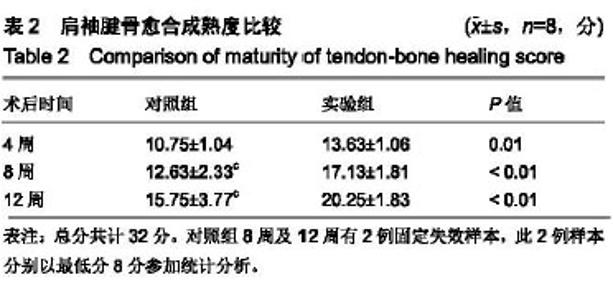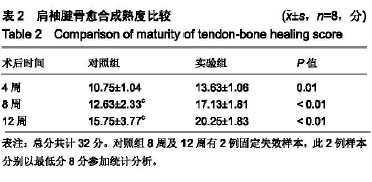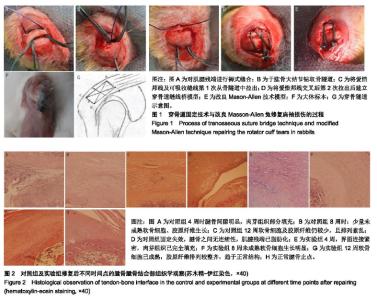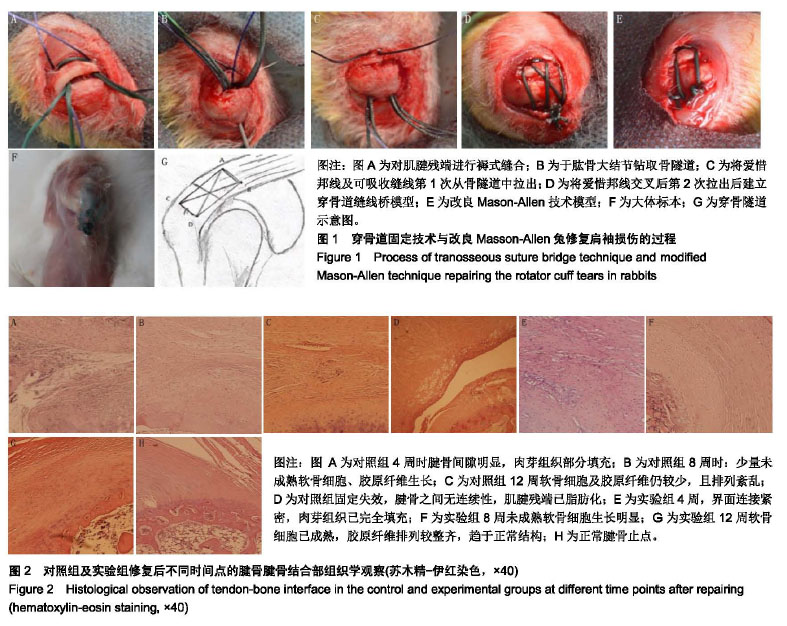| [1]刘平,敖英芳. 关节镜下缝合桥技术与双排缝合技术治疗肩袖部分损伤21例回顾性研究[J].中国运动医学杂志,2016,35(2): 137-140.[2]Curtis AS, Burbank KM, Tierney JJ, et al. The insertional footprint of the rotator cuff: an anatomic study. Arthroscopy. 2006;22(6):601-609.[3]Lohr JF, Uhthoff HK. Epidemiology and pathophysiology of rotator cuff tears. Orthopade.2007;36(9):788-795.[4]Kakoi H, Izumi T, Fujii Y, et al. Clinical outcomes of arthroscopic rotator cuff repair: a retrospective comparison of double-layer, double-row and suture bridge methods. BMC Musculoskelet Disord.2018;19(1):324.[5]Abdelshahed M, Mahure SA, Kaplan DJ, et al. Arthroscopic Rotator Cuff Repair: Double-Row Transosseous Equivalent Suture Bridge Technique. Arthrosc Tech.2016;5(6): e1297-e1304.[6]Baums MH, Kostuj T, Klinger HM, et al. Rotator cuff repair: single- vs double-row. Clinical and biomechanical results. Orthopade.2016;45(2):118-124.[7]Miyazaki AN, Santos PD, Sella GD, et al. Evaluation of the functional results after rotator cuff arthroscopic repair with the suture bridge technique. Rev Bras Ortop.2017;52(2): 164-168.[8]Park JY,Lhee SH,Oh KS,et al.Clinical and ultrasonographic outcomes of arthroscopic suture bridge repair for massive rotator cuff tear. Arthroscopy.2013;29(2):280-289.[9]Bedeir YH, Jimenez AE, Grawe BM. Recurrent tears of the rotator cuff: Effect of repair technique and management options. Orthop Rev(Pavia).2018;10(2):7593.[10]Lebaschi A, Deng XH, Zong J, et al. Animal models for rotator cuff repair. Ann N Y Acad Sci.2016;1383(1):43-57.[11]Ye W , Bao N , Zhaq J . Healing model research of rotator cuff injury in canine. Zhongguo Xiu Fu Chong Jian Wai Ke Za Zhi. 2016;30(4):461-465.[12]Novakova SS, Mahalingam VD, Florida SE, et al. Tissue-engineered tendon constructs for rotator cuff repair in sheep. J Orthop Res.2018;36(1):289-299.[13]Cheon SJ, Kim JH, Gwak HC, et al. Comparison of histologic healing and biomechanical characteristics between repair techniques for a delaminated rotator cuff tear in rabbits. J Shoulder Elbow Surg.2017;26(5):838-845.[14]Edelstein L,Thomas SJ, Soslowsky LJ. Rotator cuff tears: what have we learned from animal models?. J Musculoskelet Neuronal Interact. 2011;11(2):150-162.[15]Gerber C . Mechanical strength of repaires of the rotator cuff. J Bone Joint Surg Br. 1994;76(3):371-380.[16]Lubiatowski P, Kaczmarek P, Dzianach M, et al. Clinical and biomechanical performance of patients with failed rotator cuff repair. Int Orthop.2013;37(12):2395-2401.[17]Buess E,Steuber KU,Waibl B.Open versus arthroscopic rotator cuff repair: A comparative view of 96 cases. Arthroscopy. 2005;21( 5) : 597-604.[18]张颉鸿. Kartogenin对肩袖止点腱骨愈合的干预作用及机制研究[D].上海:第二军医大学,2016.[19]Li X, Shen P, Su W, et al. Into-Tunnel Repair Versus Onto-Surface Repair for Rotator Cuff Tears in a Rabbit Model. Am J Sports Med.2018;46(7):1711-1719.[20]李奉龙,姜春岩,鲁谊,等.兔肩袖损伤模型的建立及初步组织学研究[J].中国组织工程研究,2012,16(20):3685-3689.[21]Ide J, Kikukawa K, Hirose J, et al. Reconstruction of large rotator-cuff tears with acellular dermal matrix grafts in rats. J Shoulder Elbow Surg.2009;18(2):288-295.[22]Caldow J, Richardson M, Balakrishnan S, et al. A cruciate suture technique for rotator cuff repair. Knee Surg Sports Traumatol Arthrosc. 2015;23(2):619-626.[23]Early NA, Elias JJ, Lippitt SB, et al. Suture spanning augmentation of single-row rotator cuff repair: a biomechanical analysis. J Shoulder Elbow Surg.2017;26(2): 337-342.[24]Darling EM, Athanasiou KA. Rapid phenotypic changes in passaged articular chondrocyte subpopulations. J Orthop Res.2005;23(2):425-432.[25]dams JE, Zobitz ME, Reach JJ, et al. Rotator cuff repair using an acellular dermal matrix graft: an in vivo study in a canine model. Arthroscopy.2006;22(7):700-709.[26]Park MC, ElAttrache NS, Tibone JE, et al. Part I: Footprint contact characteristics for a transosseous-equivalent rotator cuff repair technique compared with a double-row repair technique. J Shoulder Elbow Surg. 2007;16(4):461-468.[27]费文勇.单排?传统双排及线桥技术治疗全层肩袖损伤的比较研究[D].武汉:武汉大学,2015.[28]Kim SH, Kim J, Choi YE, et al. Healing disturbance with suture bridge configuration repair in rabbit rotator cuff tear. J Shoulder Elbow Surg.2016;25(3):478-486.[29]Park MC, Tibone JE, ElAttrache NS, et al. Part II: Biomechanical assessment for a footprint-restoring transosseous-equivalent rotator cuff repair technique compared with a double-row repair technique. J Shoulder Elbow Surg.2007;16(4):469-476.[30]Hantes ME, Ono Y, Raoulis VA, et al. Arthroscopic Single-Row Versus Double-Row Suture Bridge Technique for Rotator Cuff Tears in Patients Younger Than 55 Years: A Prospective Comparative Study. Am J Sports Med. 2018; 46(1):116-121.[31]Nelson CO, Sileo MJ, Grossman MG, et al. Single-row modified mason-allen versus double-row arthroscopic rotator cuff repair: a biomechanical and surface area comparison. Arthroscopy.2008;24(8):941-948.[32]Huntington L, Richardson M, Sobol T, et al. Load response and gap formation in a single-row cruciate suture rotator cuff repair. ANZ J Surg.2017;87(6):483-487.[33]Hapa O, Karakasli A, Basci O, et al. The primary factor for suture configuration at rotator cuff repair: Width of mattress or distance from tear edge. Acta Orthop Traumatol Turc. 2016; 50(4):448-451.[34]Mazzocca AD, McCarthy MB, Chowaniec D, et al. Bone marrow-derived mesenchymal stem cells obtained during arthroscopic rotator cuff repair surgery show potential for tendon cell differentiation after treatment with insulin. Arthroscopy.2011;27(11):1459-1471.[35]Hinse S, Menard J, Rouleau D M, et al. Biomechanical study comparing 3 fixation methods for rotator cuff massive tear: Transosseous No. 2 suture, transosseous braided tape, and double-row. J Orthop Sci.2016;21(6):732-738. |



